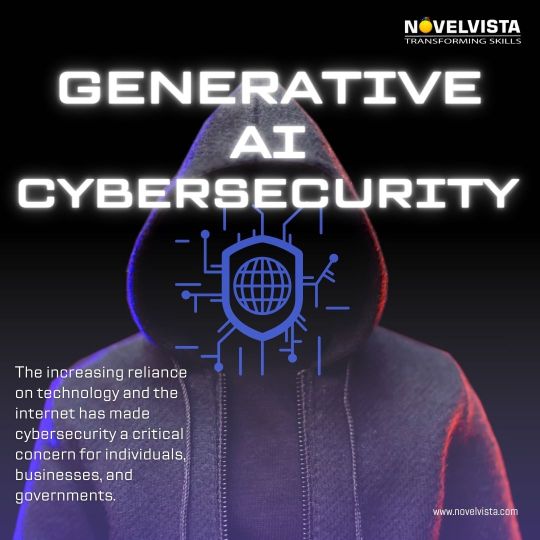#generative ai cybersecurity
Text
The Influence of Generative AI, on the Advancement of Cybersecurity Solutions
This study examines how artificial intelligence (AI) is revolutionizing cybersecurity. It provides an analysis of how AI technologiesre changing the way threats are detected defense strategies are developed and incident response is handled in the digital world. Explore the ways in which AI is improving cybersecurity measures to proactively address evolving cyber threats and strengthen security. Find out more about it here.

0 notes
Text
Next-Gen Protection: Exploring Generative AI in Cybersecurity
It delves into the transformative role of generative AI in reshaping the landscape of digital security. This exploration highlights how AI in cybersecurity isn't just a tool but a game-changer, offering unparalleled advancements in threat detection and response. By leveraging generative AI cybersecurity techniques, organizations are empowered to predict and neutralize potential cyber threats with greater accuracy and speed than ever before. The article focuses on the innovative applications of AI for cybersecurity, illustrating how generative models can simulate and anticipate complex cyberattacks, enabling proactive defense mechanisms. Read More.

0 notes
Text






Cyber Beach
#photo#photography#cyberpunk#cybercore#cyber y2k#cyber aesthetic#futuristic#futurism#cybersecurity#cybernetics#cyberpunk aesthetic#cyberpunk art#ai art#ai#ai generated#ai image#artificial intelligence#technology#machine learning#future#machine#beach#beachlife#beachwear#sea#lake#night beach#night#nightwing#sky
307 notes
·
View notes
Text
Using Local Rank Tracker for Cybersecurity SaaS Products
Local Rank Tracker not only helps improve your local search visibility but also offers valuable insights for new markets. Discover how Local Rank Tracker can bolster your SaaS product's online presence.

While cybersecurity SaaS products typically target a global market, local rank tracking can still provide valuable insights.
Here's how to adapt local rank for your growth:
1. Track Rankings in Key Markets
Identify primary geographic markets where your target customers are concentrated.
Set up tracking for major cities or regions in these markets.
Monitor rankings for your main keywords in these locations.
Use tools like Google Analytics to identify your top traffic sources by location.
2. Competitor Analysis
Track your competitors' rankings in the same locations.
Identify gaps and opportunities in different markets.
Use tools like SEMrush or Ahrefs to conduct comprehensive competitor analysis.
3. Language-Specific Tracking
If your product is available in multiple languages, track rankings for each language version.
Use location-specific domains (e.g., .co.uk, .de) if applicable.
Consider using hreflang tags to specify language and regional URLs.
4. Industry-Specific Keywords
Track rankings for cybersecurity-specific terms.
Include both technical terms and more general security-related keywords.
Utilize cybersecurity glossaries to identify relevant technical terms.
5. Mobile vs. Desktop Tracking
Compare rankings across devices, as B2B searches may differ between mobile and desktop.
Use Google's Mobile-Friendly Test to ensure your pages are optimized for mobile.
6. Local Content Performance
If you create location-specific landing pages or content, track their performance in relevant areas.
Implement proper URL structures for international SEO (e.g., example.com/uk/ for UK-specific content).
7. SERP Feature Tracking
Monitor your appearance in featured snippets, knowledge panels, and other SERP features.
These can be particularly important for informational cybersecurity queries.
Optimize your content for featured snippets by providing clear, concise answers to common questions.
8. Keyword Opportunities
Use the tracker to identify new keyword opportunities in different markets.
Look for terms where you're ranking just off the first page and focus optimization efforts there.
Use Google's Keyword Planner or tools like Moz Keyword Explorer to find related keywords.
9. Localized Ad Performance
If running localized PPC campaigns, use the tracker to compare organic vs. paid performance in different areas.
Integrate your SEO and PPC strategies for maximum impact.
10. Seasonal Trends
Track how rankings fluctuate during key periods (e.g., major conferences, fiscal year-end for enterprises).
Use Google Trends to identify seasonal patterns in cybersecurity-related searches.
11. Regulatory Impact
Monitor how rankings change in different jurisdictions as new cybersecurity regulations are introduced.
Stay informed about global cybersecurity regulations through resources like the NIST Cybersecurity Framework.
Implementation Tips
Choose the Right Rank Tracker:
Look for tools that offer multiple location tracking, such as BrightLocal, Moz Local, or SEMrush.
Ensure the tool can track rankings for both organic results and SERP features.
Consider tools that integrate with your other SEO and analytics platforms for seamless data analysis.
Key features to look for:
Ability to track rankings in multiple countries and cities
Support for tracking mobile and desktop rankings separately
Integration with Google Search Console and Google Analytics
Customizable reporting features
Set Up Comprehensive Alerts:
Configure alerts for significant ranking changes (e.g., moving into or out of the top 10).
Set up competitor alerts to be notified when competitors make significant ranking gains.
Use different alert thresholds for different keyword priorities:
High-priority keywords: Alert for any change in ranking
Medium-priority keywords: Alert for changes of 3 positions or more
Low-priority keywords: Alert for changes of 5 positions or more
Consider setting up daily or weekly digest emails summarizing all ranking changes.
Establish a Regular Review Process:
Schedule weekly or bi-weekly ranking review sessions with your SEO team.
Create a standardized review template that includes:
Overall ranking trends
Top gaining and declining keywords
New ranking opportunities (keywords ranking 11-20)
Competitor movement
Use project management tools like Trello or Asana to assign and track optimization tasks based on ranking data.
Correlate Rankings with Performance Metrics:
Set up Google Analytics goals for key conversion actions (e.g., demo requests, whitepaper downloads).
Use Google Looker Data Studio or similar tools to create dashboards that combine ranking data with traffic and conversion metrics.
Calculate the estimated traffic value of your rankings using average CTR data and estimated CPC from Google Ads.
Regularly assess the ROI of your SEO efforts by comparing ranking improvements to increases in conversions and revenue.
Utilize Data Visualization for Stakeholder Reports:
Create visually appealing reports using tools like Google Data Studio, Tableau, or PowerBI.
Design different report templates for different stakeholders:
Executive summary for C-level executives
Detailed performance reports for the marketing team
Competitor comparison reports for product teams
Include key visualizations such as:
Ranking distribution charts
Keyword movement heatmaps
Geographic ranking maps
Year-over-year or month-over-month comparison charts
Integrate Ranking Data into Your Content Strategy:
Use ranking data to identify content gaps and opportunities.
Create a content calendar that prioritizes topics based on ranking potential and business impact.
Implement a regular content audit process, using ranking data to identify underperforming content for optimization.
Use tools like MarketMuse or Clearscope to optimize content based on top-ranking competitors for target keywords.
Leverage API Integrations:
If your rank tracking tool offers an API, integrate it with your internal dashboards or reporting tools.
Consider building custom applications to automate analysis and reporting tasks.
Use webhooks to trigger automated workflows based on ranking changes (e.g., Slack notifications for significant drops).
Conduct Regular Tool Audits:
Periodically review the accuracy of your rank tracking tool by manually verifying a sample of rankings.
Stay informed about updates to search engine algorithms and ensure your rank tracking tool adapts accordingly.
Annually assess whether your current tool still meets your needs or if you should explore alternatives.
Train Your Team:
Provide regular training sessions on how to interpret and act on ranking data.
Create internal documentation on your rank tracking processes and best practices.
Encourage team members to obtain relevant certifications (e.g., Google Analytics, SEMrush) to enhance their skills in data analysis and interpretation.
By following these detailed implementation tips, you can ensure that you're making the most of your local rank tracking efforts for your cybersecurity SaaS product. Remember to continually refine your processes based on the insights you gain and the evolving landscape of search engine optimization.
Visit for more Info: https://gracker.ai/
#ai generated#content creation#content marketing#cybersecurity#search engine optimisation#saas product#content strategy
0 notes
Text

📘•°•📙 Treacherous Technology 📙•°•📘
📣👉Available On Amazon👈💥
🛒👉Here is the book link:- https://a.co/d/7DekmGX
Treacherous Technology: Generative AI and Quantum Computers - A Discussion of the risks posed by innovative technologies
Book purchase Link :-
📘✍Author by Joe Bartolo J.D. (Author)
✨️✨️✨️✨️✨️✨️✨️✨️✨️✨️✨️✨️✨️✨️✨️✨️✨️✨️✨️✨️
📙🖋A Discission of risks posed by modern solutions:
💥 Generative AI: The power to create art, music, and human-like text, but also the capacity to produce deepfakes and misinformation at an alarming scale.
💥 Quantum Computing: The promise of solving complex problems in seconds, juxtaposed with the risk of breaking modern encryption and compromising global security.
💥 Ethical Implications: The moral questions surrounding the deployment of these technologies, including biases in AI algorithms and the environmental impact of quantum computing.
💥 Real-World Scenarios: Case studies and hypothetical situations that illustrate the potential hazards and benefits of our rapidly advancing technological landscape.
📘✍"Treacherous Technology" is an essential read for anyone eager to understand the balance between harnessing the power of new technologies and safeguarding our future. Whether you're a tech enthusiast, a professional in the field, or a concerned citizen, this book offers a comprehensive guide to the promises and perils that lie ahead.
Treacherous Technology
🛒👉Here is the book link:
📣📕📗
⭐️⭐️⭐️(Author) by Joe Bartolo, J.D.
💗💖"
🛒👉Available Instantly on Amazon –
Order Now:
Treacherous Technology: Generative AI and Quantum Computers - A Discussion of the risks posed by innovative technologies:- https://books2read.com/u/47BEVg
#AI;#Generative;#Artificial;#Intelligence;#GAI;#Quantum;#Singularity;#Supremacy;#Q-Day;#Innovation;#risk_management;#risk;#compliance;#legal;#privacy;#cybersecurity;#deepfake;#edrm;#aceds;#arma;#iapp;#sali#Law#Book#Books#Bookworm#BookLover#Bookish#BookAddict#BookLove
0 notes
Text
The 3 Pillars of AI in Cybersecurity
New Post has been published on https://thedigitalinsider.com/the-3-pillars-of-ai-in-cybersecurity/
The 3 Pillars of AI in Cybersecurity
Artificial intelligence (AI) has taken the cybersecurity industry by storm, with vendors of all kinds working to integrate AI into their solutions. But the relationship between AI and security is about more than implementing AI capabilities—it’s about how both attackers and defenders are leveraging the technology to change the face of the modern threat landscape. It’s also about how those AI models are developed, updated, and protected. Today, there are three primary pillars of AI in cybersecurity—and as a growing number of organizations turn to security providers with AI-based solutions, it’s increasingly important to understand how that technology is actually being used.
Pillar #1: Defending AI Capabilities
As the adoption of AI-based solutions continues to skyrocket, businesses are increasingly recognizing that protecting those solutions must be a priority. AI solutions are trained on massive amounts of data (the more data, the more accurate the solution), which means an attacker who manages to breach one of those solutions might be sitting on a treasure trove of customer data, intellectual property, financial information, and other valuable assets. With attackers leveraging these attack vectors at a growing rate, the first line of defense for organizations is their ability to defend the AI models they are using on a day-to-day basis.
Fortunately, this problem isn’t a secret—in fact, the market for solutions specifically designed to protect AI models is growing rapidly, with a significant number of startups emerging over the past year or two. It’s also important to remember that while solutions like generative AI are relatively new, AI has been around for quite a while—and most AI solutions have some degree of security built into them. That said, organizations should always take any additional steps necessary to protect themselves and their data, and there is no shortage of third-party solutions that can help defend AI pipelines against attackers looking for an easy score.
Pillar #2: Stopping the Attackers Who Are Using AI
With AI growing increasingly accessible, it should come as little surprise that attackers are leveraging the technology for their own ends. Just as AI is allowing organizations to streamline their operations and automate tedious and repetitive processes, it is also helping attackers increase the scale and complexity of their attacks. In practical terms, attackers aren’t really using AI to carry out “new” types of attacks—at least not yet. But the technology is making it easier to engage in existing attack tactics at an extremely high volume.
For example, phishing scams are a numbers game—if just 1% of recipients click a malicious link, that’s a win for the attacker. But with the help of AI, attackers can apply an unprecedented level of personalization to their phishing emails, making them more convincing—and dangerous—than ever. Worse still, once an organization has been compromised (via phishing or other means), the attacker can leverage AI to analyze discovery data and create a decision-making process that makes propagation both easier and stealthier. The more attackers can automate propagation, the faster they can reach their objective—often before traditional security tools can even identity the attack, let alone respond to it effectively.
That means organizations need to be ready—and it starts with having solutions in place that can identify and defend against these high-volume, high-complexity attacks. While many businesses may have solutions in place to defend against phishing scams, malware attacks, and other vectors, it’s important to test those solutions to be sure they remain effective as attacks grow more frequent and complex. Security leaders must remember that it isn’t just about having the right solutions in place—it’s about making sure they are working as expected against real-world threats.
Pillar #3: Using AI in Cybersecurity Products
The final pillar is the one that security professionals will be most familiar with: cybersecurity vendors using AI in their products. One of the things AI is best at is identifying patterns, which makes it ideal for identifying suspicious or abnormal activity. A growing number of vendors are deploying AI in their detection solutions, and many are also leveraging AI to automate certain elements of remediation as well. In the past, dealing with low-level threats has been a tedious but necessary element of cybersecurity. Today, AI can automate much of that process, dealing with minor incidents automatically and allowing security professionals to focus on only the threats that demand direct attention.
This has added significant value to a wide range of security solutions, but it doesn’t happen in a vacuum. AI models need to be maintained, and it’s important to work with vendors that have a reputation for keeping their models consistently updated. Vetting potential security partners is critical, and organizations need to know how vendors work with AI: where their data comes from, how they avoid problems like inherent bias, and other factors can (and should) impact the decision on whether to work with a certain vendor. While AI solutions are gaining traction in almost every industry, they aren’t all created equal. Organizations need to ensure they are working with security partners who understand the ins and outs of the technology, rather than vendors who see “AI” simply as a marketing buzzword.
Approaching AI with Confidence
As AI becomes increasingly ubiquitous across the cybersecurity landscape, it is important for organizations to familiarize themselves with the ways in which the technology is actually being used. That means understanding both the ways in which AI can improve security solutions and the ways in which it can help attackers craft more advanced attacks. It also means recognizing that the data upon which today’s AI models are built needs to be protected—and working with vendors that prioritize deploying the technology safely and securely is critical. By understanding the three main pillars of AI and security, organizations can ensure they have the baseline knowledge needed to approach the technology with confidence.
#Advanced attacks#ai#AI models#approach#artificial#Artificial Intelligence#assets#attackers#attention#Bias#breach#change#complexity#craft#customer data#cyber security#cybersecurity#data#defenders#defense#deploying#detection#easy#emails#financial#focus#game#generative#generative ai#how
0 notes
Text
Learn top generative AI cybersecurity practices. Enhance your data security and protect against cyber threats effectively.
#AI Cybersecurity Strategies#AI in Cybersecurity#AI-Powered Cybersecurity#Cyber Security Protection#Generative AI#Generative AI Cybersecurity Policies#Generative AI Development
0 notes
Text
Learn top generative AI cybersecurity practices. Enhance your data security and protect against cyber threats effectively.
#AI Cybersecurity Strategies#AI in Cybersecurity#AI-Powered Cybersecurity#Cyber Security Protection#Generative AI#Generative AI Cybersecurity Policies#Generative AI Development
0 notes
Text
Best Practices for Generative AI Cybersecurity Policies

Original source : Best Practices for Generative AI Cybersecurity Policies
The application of Generative AI technologies grows as a result of the progression in technology and the display of Generative AI in many sectors such as cybersecurity. Thus, along with these opportunities there appear new threats and vice versa. This implies that it is vital to establish effective cybersecurity policies that are relevant in the Generative AI environment to enhance data security and system’s safety. This article focuses on the general practices in the formulation and management of Generative AI cybersecurity policies.
1. Understanding the Role of Generative AI in Cybersecurity
Generative AI is AI that is designed and programmed to create new content of text, image or even code. In cybersecurity, Generative AI can be once again appear as both a blessing and a curse. On the one hand, it holds definite benefits in identification of threats and vulnerabilities and automated response. For example, Generative AI can study the huge pile of information to discover the signals of potential threats and respond with protections or warnings instantaneously.
At the same time, the same opportunities can be used by the attacker to create an advanced cyber threat. Thus, Generative AI can become weaponized and one can think of AI-generated phishing emails, malware or deepfakes, for instance. It is important to recognize these dual roles so that organizations can better develop end-to-end AI cybersecurity strategies.
2. Key Principles for a Robust Generative AI Cybersecurity Policy
Formulating a Generative AI cybersecurity policy entails the following principles in order to be effective as well as sustainable. These principles include:
1. Transparency: The design of AI systems must be such a way that its decision making process has to be well explained and must be clear. This is useful when trying to explain activity of an AI or when attempting to avoid certain behaviors that were not foreseen when designing the AI.
2. Accountability: Creating these accountabilities’ structures, on the other hand, is crucial. This cuts along the aspects of assigning accountability of AI decisions, and also guaranteeing techniques to review and correct purposes of AI when required.
3. Data Integrity: Being the sources of AI, the data have to remain sacred and secure at all times. Security should be applied in terms of strict guidelines to follow when dealing with data so as to avoid exposure and misuse.
4. Ethical Considerations: Ethical standards of AI systems should prohibit punitive action across the society and also avoid biased action. This is in regard to gender biases in textual outputs as well as guaranteeing that AI and apps it’s used in do not infringe privacy.
3. Defining Scope and Objectives of the Generative AI Cybersecurity Policy
A good starting point for strengthening a cybersecurity policy is developing a clear statement of the problem’s scope and goals. For Generative AI, this involves:
Scope: It is important to divide certain borders of the policy. State which AI systems the policy applies to, what kind of data is used and where the AI systems operate. This clarity is actually very useful in that it provides a specific focus to policy implementation and enforcement.
Objectives: State tangible targets at which the policy is directed to arrive. Challenges may include prevention of emergence of additional AI-facilitated cyber threats, improvement of AI solutions’ capabilities in terms of threat identification and mitigation, and adherence to the existing legislation and norms.
4. AI Governance and Oversight for Effective Generative AI Cybersecurity
Organization and supervision are some of the fundamental essentials of an adequate AI cybersecurity policy. Good governance practices also aim at ensuring that proper standards and best practices are followed in the creation and operation of AI systems. Key aspects include:
1. Governance Framework: Organise AI cybersecurity in a formal way that would involve defining the set of rules that state who is responsible for what and how it should be done. These should be conducted from time to time and the framework developed updated to reflect changes in threats and technology.
2. Oversight Mechanisms: Perform self-assessments as well as independent assessments within the organization to confirm compliance to the policy. These mechanisms are useful for detecting possible risks and ensuring proper AI functionality and behavior.
5. Implementing and Enforcing the Generative AI Cybersecurity Policy
The effectiveness of policies begins with the execution or administrative phase; this is where policies are put into practice. Key steps include:
1. Training and Awareness: Enlighten the policy to the stakeholders, developers, users and the management on the importance of the policy. It stresses on the resolution that exhibitions or training sessions could be held consistently to assure all of the team that they are well aware of their responsibilities to protect AI cybersecurity.
2. Technical Controls: Use safeguards like access controls, encryption, and use of anomaly detection systems to protect AI applications and the related data. These controls are known as the first level of Cyber security protection mechanisms.
3. Incident Response Plans: Create and update as a priority dedicated plans, which relate to possible incidents concerning AI systems. It is recommended that such elaborate plans should indicate measures of identification, action and management in case of an incident involving artificial intelligence in cyber security.
4. Regular Audits and Reviews: Also, the use of AI must be audited and reviewed periodically in order to find weaknesses in the AI systems and/or plans. It’s required to improve the strategies relied on to counter the new threats periodically.
6. Conclusion: Staying Ahead of Evolving Generative AI Cybersecurity Threats
The possibilities of Generative AI development grow extremely fast, and this provides more opportunities and threats in cybersecurity. Therefore, in order to manage the risks associated with AI while realizing their potential, when developing the Generative AI policy, it is necessary to:
It is also crucial to constantly monitor and adapt to new AI cybersecurity threats and endorse strict ethical standards in the development and implementation of AI technologies. It implies that as AI technologies continue to develop, new strategies of defending against cyber threats are needed and trust to the AI systems and data must be preserved.
In conclusion, it is not only a technical requirement but also a strategic one to build extensive Generative AI cybersecurity policies. Organizations that are in a position to deal with these AI cybersecurity threats shall therefore be better placed to fully capitalize on the possibilities of AI innovations without similar future risks.
Original source : Best Practices for Generative AI Cybersecurity Policies
#AI Cybersecurity Strategies#AI in Cybersecurity#AI-Powered Cybersecurity#Cyber Security Protection#Generative AI#Generative AI Cybersecurity Policies#Generative AI Development
0 notes
Text
The Evolution of Cybersecurity: Embracing Generative AI Technologies
It explores the transformative role of AI in cybersecurity. It delves into how generative AI cybersecurity strategies are reshaping defense mechanisms, offering advanced solutions to combat digital threats. Highlighting the integration of AI for cybersecurity, the piece underscores the synergy between artificial intelligence and digital protection, marking a new era in AI cybersecurity. Read More.

0 notes
Text

It explores the transformative role of AI in cybersecurity. It delves into how generative AI cybersecurity strategies are reshaping defense mechanisms, offering advanced solutions to combat digital threats. Highlighting the integration of AI for cybersecurity, the piece underscores the synergy between artificial intelligence and digital protection, marking a new era in AI cybersecurity. Read More.
0 notes
Text







City
#photo#photography#cyberpunk#cybercore#cyber y2k#cyber aesthetic#futuristic#futurism#cybersecurity#cybernetics#cyberpunk aesthetic#cyberpunk art#ai art#ai#ai generated#ai image#artificial intelligence#technology#machine learning#future#machine#beach#beachlife#beachwear#sea#lake#night beach#night#nightwing#sky
3 notes
·
View notes
Text
ISB Executive Education and Emeritus Unveil New Cybersecurity Program for Leaders.

Mumbai: ISB Executive Education has announced the launch of the Cybersecurity for Leaders program in collaboration with Emeritus, acknowledging cybersecurity as a key priority for risk management and leadership. Emeritus specializes in ensuring that high-quality education is both accessible and affordable for both individuals and organizations.
ALSO READ MORE- https://apacnewsnetwork.com/2024/07/isb-executive-education-and-emeritus-unveil-new-cybersecurity-program-for-leaders/
#AI and Generative AI#Cybersecurity#ISB Executive Education#ISB Executive Education and Emeritus Unveil#New Cybersecurity Program
0 notes
Text

"Top Cyber Threats Every Business Should Know" outlines the most pressing cybersecurity risks companies face today. It includes how Gracker.ai can be instrumental in mitigating these threats by providing sophisticated threat detection, real-time alerts, and detailed analytics. Discover how Gracker.ai helps businesses stay vigilant and protect against emerging cyber threats effectively.
#cybersecurity#ai generated#content creation#content marketing#seo services#seo strategy#content strategy#seo marketing#blog strategy#search engine optimisation
0 notes
Text

📘•°•📙 Treacherous Technology 📙•°•📘
📣👉Available On Amazon👈💥
🛒👉Here is the book link:- https://a.co/d/7DekmGX
Treacherous Technology: Generative AI and Quantum Computers - A Discussion of the risks posed by innovative technologies
Book purchase Link :-
📘✍Author by Joe Bartolo J.D. (Author)
✨️✨️✨️✨️✨️✨️✨️✨️✨️✨️✨️✨️✨️✨️✨️✨️✨️✨️✨️✨️
📙🖋A Discission of risks posed by modern solutions:
💥 Generative AI: The power to create art, music, and human-like text, but also the capacity to produce deepfakes and misinformation at an alarming scale.
💥 Quantum Computing: The promise of solving complex problems in seconds, juxtaposed with the risk of breaking modern encryption and compromising global security.
💥 Ethical Implications: The moral questions surrounding the deployment of these technologies, including biases in AI algorithms and the environmental impact of quantum computing.
💥 Real-World Scenarios: Case studies and hypothetical situations that illustrate the potential hazards and benefits of our rapidly advancing technological landscape.
📘✍"Treacherous Technology" is an essential read for anyone eager to understand the balance between harnessing the power of new technologies and safeguarding our future. Whether you're a tech enthusiast, a professional in the field, or a concerned citizen, this book offers a comprehensive guide to the promises and perils that lie ahead.
Treacherous Technology
🛒👉Here is the book link:
📣📕📗
⭐️⭐️⭐️(Author) by Joe Bartolo, J.D.
💗💖"
🛒👉Available Instantly on Amazon –
Order Now:
Treacherous Technology: Generative AI and Quantum Computers - A Discussion of the risks posed by innovative technologies:- https://books2read.com/u/47BEVg
📣📕📗
#AI;#Generative;#Artificial;#Intelligence;#GAI;#Quantum;#Singularity;#Supremacy;#Q-Day;#Innovation;#risk_management;#risk;#compliance;#legal;#privacy;#cybersecurity;#deepfake;#edrm;#aceds;#arma;#iapp;#sali#Law#Book#Books#Bookworm#BookLover#Bookish#BookAddict#BookLove
0 notes
Text
You and me (social media users) have been targeted by Russia. DOJ, FBI and others are working to defend us.
Sometimes the online troll you encounter is, without exaggeration, a weapon being used against you.
“…Justice Department and our partners will not tolerate Russian government actors…deploying AI to sow disinformation and fuel division among Americans,”
https://www.justice.gov/opa/pr/justice-department-leads-efforts-among-federal-international-and-private-sector-partners
#infosec #cyber #security #InformationWarfare #CyberWarfare #cybersecurity #russia #fsb
0 notes